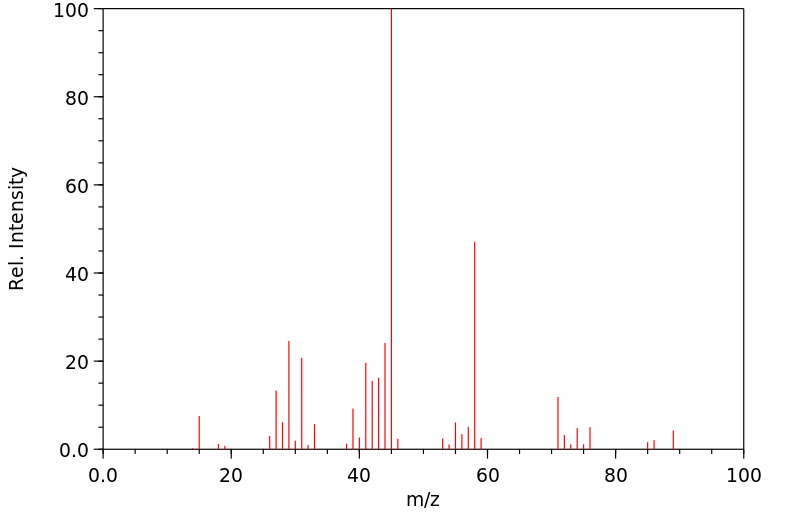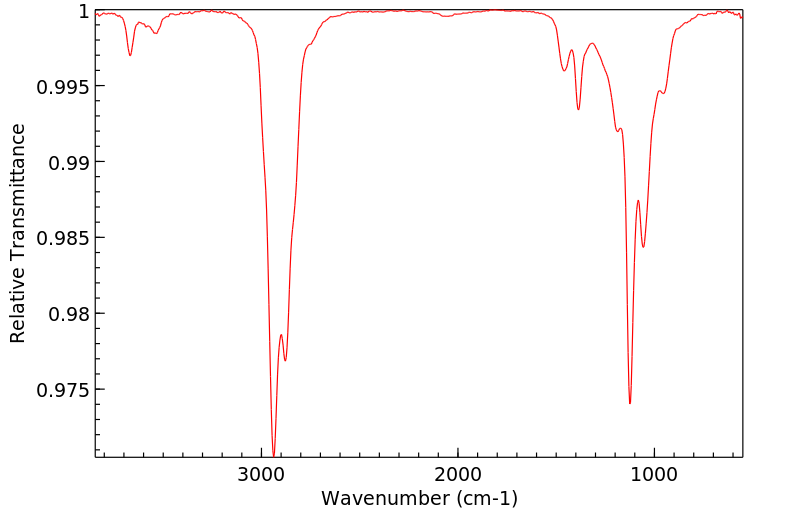4-甲氧基-1-丁醇 | 111-32-0
物质功能分类
中文名称
4-甲氧基-1-丁醇
中文别名
四亚甲基乙二醇单丁醚;1,4-丁二醇单甲醚;4-甲氧基丁-1-醇;4-甲氧基丁醇;1,4-丁二醇甲醚;2-叔丁氧基氨基乙醚
英文名称
4-methoxybutanol
英文别名
4-methoxybutan-1-ol;1,4-butanediol monomethyl ether;4-methoxy-1-butanol
CAS
111-32-0
化学式
C5H12O2
mdl
MFCD00040437
分子量
104.149
InChiKey
KOVAQMSVARJMPH-UHFFFAOYSA-N
BEILSTEIN
——
EINECS
——
-
物化性质
-
计算性质
-
ADMET
-
安全信息
-
SDS
-
制备方法与用途
-
上下游信息
-
文献信息
-
表征谱图
-
同类化合物
-
相关功能分类
-
相关结构分类
物化性质
-
沸点:66 °C / 7mmHg
-
密度:0.93
-
闪点:73°(163°F)
-
保留指数:886
-
稳定性/保质期:
避免与氧化物接触。
计算性质
-
辛醇/水分配系数(LogP):0.1
-
重原子数:7
-
可旋转键数:4
-
环数:0.0
-
sp3杂化的碳原子比例:1.0
-
拓扑面积:29.5
-
氢给体数:1
-
氢受体数:2
安全信息
-
危险等级:3
-
危险品标志:F
-
危险类别码:R36/37/38
-
危险品运输编号:UN1993
-
RTECS号:EL4550000
-
海关编码:2909499000
-
包装等级:III
-
危险类别:3
-
安全说明:S26,S36/37/39
-
危险性防范说明:P210,P280,P370+P378,P403+P235,P501
-
危险性描述:H225
-
储存条件:密封于阴凉、干燥处保存。确保工作间有良好的通风和防爆设施,并远离火源和防静电环境。储存地点应远离氧化剂和空气。
SDS
1,4-丁二醇单甲醚 修改号码:5
模块 1. 化学品
产品名称: 1,4-Butanediol Monomethyl Ether
修改号码: 5
模块 2. 危险性概述
GHS分类
物理性危害
易燃液体 第4级
健康危害 未分类
环境危害 未分类
GHS标签元素
图标或危害标志 无
信号词 警告
危险描述 可燃液体
防范说明
[预防] 远离明火/热表面。
穿戴防护手套/护目镜/防护面具。
[储存] 存放于通风良好处。保持凉爽。
[废弃处置] 根据当地政府规定把物品/容器交与工业废弃处理机构。
模块 3. 成分/组成信息
单一物质/混和物 单一物质
化学名(中文名): 1,4-丁二醇单甲醚
百分比: >98.0%(GC)
CAS编码: 111-32-0
俗名: 4-Methoxy-1-butanol , Tetramethylene Glycol Monomethyl Ether
分子式: C5H12O2
模块 4. 急救措施
吸入: 将受害者移到新鲜空气处,保持呼吸通畅,休息。若感不适请求医/就诊。
皮肤接触: 立即去除/脱掉所有被污染的衣物。用水清洗皮肤/淋浴。
若皮肤刺激或发生皮疹:求医/就诊。
眼睛接触: 用水小心清洗几分钟。如果方便,易操作,摘除隐形眼镜。继续清洗。
如果眼睛刺激:求医/就诊。
食入: 若感不适,求医/就诊。漱口。
1,4-丁二醇单甲醚 修改号码:5
紧急救助者的防护: 救援者需要穿戴个人防护用品,比如橡胶手套和气密性护目镜。
模块 5. 消防措施
合适的灭火剂: 干粉,泡沫,二氧化碳
不适用的灭火剂: 水(有可能扩大灾情。)
特定方法: 从上风处灭火,根据周围环境选择合适的灭火方法。
非相关人员应该撤离至安全地方。
周围一旦着火:如果安全,移去可移动容器。
消防员的特殊防护用具: 灭火时,一定要穿戴个人防护用品。
模块 6. 泄漏应急处理
个人防护措施,防护用具, 使用个人防护用品。远离溢出物/泄露处并处在上风处。确保足够通风。
紧急措施: 泄露区应该用安全带等圈起来,控制非相关人员进入。
环保措施: 防止进入下水道。
控制和清洗的方法和材料: 用合适的吸收剂(如:旧布,干砂,土,锯屑)吸收泄漏物。一旦大量泄漏,筑堤控
制。附着物或收集物应该立即根据合适的法律法规废弃处置。
副危险性的防护措施 移除所有火源。一旦发生火灾应该准备灭火器。使用防火花工具和防爆设备。
7. 操作处置与储存
处理
技术措施: 在通风良好处进行处理。穿戴合适的防护用具。防止烟雾产生。远离明火和热表面。
采取措施防止静电积累。使用防爆设备。处理后彻底清洗双手和脸。
注意事项: 使用封闭系统,通风。
操作处置注意事项: 避免接触皮肤、眼睛和衣物。
贮存
储存条件: 保持容器密闭。存放于凉爽、阴暗、通风良好处。
远离不相容的材料比如氧化剂存放。
包装材料: 依据法律。
模块 8. 接触控制和个体防护
工程控制: 尽可能安装封闭体系或局部排风系统,操作人员切勿直接接触。同时安装淋浴器和洗
眼器。
个人防护用品
呼吸系统防护: 防毒面具。依据当地和政府法规。
手部防护: 防护手套。
眼睛防护: 安全防护镜。如果情况需要,佩戴面具。
皮肤和身体防护: 防护服。如果情况需要,穿戴防护靴。
模块 9. 理化特性
外形(20°C): 液体
外观: 透明
颜色: 无色-几乎无色
气味: 无资料
pH: 无数据资料
熔点: 无资料
沸点/沸程 66 °C/0.9kPa
闪点: 无资料
爆炸特性
爆炸下限: 无资料
爆炸上限: 无资料
密度: 0.93
1,4-丁二醇单甲醚 修改号码:5
模块 9. 理化特性
溶解度:
[水] 无资料
[其他溶剂] 无资料
模块 10. 稳定性和反应性
化学稳定性: 一般情况下稳定。
危险反应的可能性: 未报道特殊反应性。
避免接触的条件: 明火
须避免接触的物质 氧化剂
危险的分解产物: 一氧化碳, 二氧化碳
模块 11. 毒理学信息
急性毒性: orl-rat LDLo:4 g/kg
对皮肤腐蚀或刺激: 无资料
对眼睛严重损害或刺激: 无资料
生殖细胞变异原性: 无资料
致癌性:
IARC = 无资料
NTP = 无资料
生殖毒性: 无资料
RTECS 号码: EL4550000
模块 12. 生态学信息
生态毒性:
鱼类: 无资料
甲壳类: 无资料
藻类: 无资料
残留性 / 降解性: 无资料
潜在生物累积 (BCF): 无资料
土壤中移动性
log水分配系数: 无资料
土壤吸收系数 (Koc): 无资料
亨利定律 无资料
constaNT(PaM3/mol):
模块 13. 废弃处置
如果可能,回收处理。请咨询当地管理部门。建议在装有后燃和洗涤装置的化学焚烧炉中焚烧。废弃处置时请遵守
国家、地区和当地的所有法规。
模块 14. 运输信息
联合国分类: 与联合国分类标准不一致
UN编号: 未列明
模块 15. 法规信息
《危险化学品安全管理条例》(2002年1月26日国务院发布,2011年2月16日修订): 针对危险化学品的安全使用、
生产、储存、运输、装卸等方面均作了相应的规定。
1,4-丁二醇单甲醚 修改号码:5
模块16 - 其他信息
N/A
模块 1. 化学品
产品名称: 1,4-Butanediol Monomethyl Ether
修改号码: 5
模块 2. 危险性概述
GHS分类
物理性危害
易燃液体 第4级
健康危害 未分类
环境危害 未分类
GHS标签元素
图标或危害标志 无
信号词 警告
危险描述 可燃液体
防范说明
[预防] 远离明火/热表面。
穿戴防护手套/护目镜/防护面具。
[储存] 存放于通风良好处。保持凉爽。
[废弃处置] 根据当地政府规定把物品/容器交与工业废弃处理机构。
模块 3. 成分/组成信息
单一物质/混和物 单一物质
化学名(中文名): 1,4-丁二醇单甲醚
百分比: >98.0%(GC)
CAS编码: 111-32-0
俗名: 4-Methoxy-1-butanol , Tetramethylene Glycol Monomethyl Ether
分子式: C5H12O2
模块 4. 急救措施
吸入: 将受害者移到新鲜空气处,保持呼吸通畅,休息。若感不适请求医/就诊。
皮肤接触: 立即去除/脱掉所有被污染的衣物。用水清洗皮肤/淋浴。
若皮肤刺激或发生皮疹:求医/就诊。
眼睛接触: 用水小心清洗几分钟。如果方便,易操作,摘除隐形眼镜。继续清洗。
如果眼睛刺激:求医/就诊。
食入: 若感不适,求医/就诊。漱口。
1,4-丁二醇单甲醚 修改号码:5
紧急救助者的防护: 救援者需要穿戴个人防护用品,比如橡胶手套和气密性护目镜。
模块 5. 消防措施
合适的灭火剂: 干粉,泡沫,二氧化碳
不适用的灭火剂: 水(有可能扩大灾情。)
特定方法: 从上风处灭火,根据周围环境选择合适的灭火方法。
非相关人员应该撤离至安全地方。
周围一旦着火:如果安全,移去可移动容器。
消防员的特殊防护用具: 灭火时,一定要穿戴个人防护用品。
模块 6. 泄漏应急处理
个人防护措施,防护用具, 使用个人防护用品。远离溢出物/泄露处并处在上风处。确保足够通风。
紧急措施: 泄露区应该用安全带等圈起来,控制非相关人员进入。
环保措施: 防止进入下水道。
控制和清洗的方法和材料: 用合适的吸收剂(如:旧布,干砂,土,锯屑)吸收泄漏物。一旦大量泄漏,筑堤控
制。附着物或收集物应该立即根据合适的法律法规废弃处置。
副危险性的防护措施 移除所有火源。一旦发生火灾应该准备灭火器。使用防火花工具和防爆设备。
7. 操作处置与储存
处理
技术措施: 在通风良好处进行处理。穿戴合适的防护用具。防止烟雾产生。远离明火和热表面。
采取措施防止静电积累。使用防爆设备。处理后彻底清洗双手和脸。
注意事项: 使用封闭系统,通风。
操作处置注意事项: 避免接触皮肤、眼睛和衣物。
贮存
储存条件: 保持容器密闭。存放于凉爽、阴暗、通风良好处。
远离不相容的材料比如氧化剂存放。
包装材料: 依据法律。
模块 8. 接触控制和个体防护
工程控制: 尽可能安装封闭体系或局部排风系统,操作人员切勿直接接触。同时安装淋浴器和洗
眼器。
个人防护用品
呼吸系统防护: 防毒面具。依据当地和政府法规。
手部防护: 防护手套。
眼睛防护: 安全防护镜。如果情况需要,佩戴面具。
皮肤和身体防护: 防护服。如果情况需要,穿戴防护靴。
模块 9. 理化特性
外形(20°C): 液体
外观: 透明
颜色: 无色-几乎无色
气味: 无资料
pH: 无数据资料
熔点: 无资料
沸点/沸程 66 °C/0.9kPa
闪点: 无资料
爆炸特性
爆炸下限: 无资料
爆炸上限: 无资料
密度: 0.93
1,4-丁二醇单甲醚 修改号码:5
模块 9. 理化特性
溶解度:
[水] 无资料
[其他溶剂] 无资料
模块 10. 稳定性和反应性
化学稳定性: 一般情况下稳定。
危险反应的可能性: 未报道特殊反应性。
避免接触的条件: 明火
须避免接触的物质 氧化剂
危险的分解产物: 一氧化碳, 二氧化碳
模块 11. 毒理学信息
急性毒性: orl-rat LDLo:4 g/kg
对皮肤腐蚀或刺激: 无资料
对眼睛严重损害或刺激: 无资料
生殖细胞变异原性: 无资料
致癌性:
IARC = 无资料
NTP = 无资料
生殖毒性: 无资料
RTECS 号码: EL4550000
模块 12. 生态学信息
生态毒性:
鱼类: 无资料
甲壳类: 无资料
藻类: 无资料
残留性 / 降解性: 无资料
潜在生物累积 (BCF): 无资料
土壤中移动性
log水分配系数: 无资料
土壤吸收系数 (Koc): 无资料
亨利定律 无资料
constaNT(PaM3/mol):
模块 13. 废弃处置
如果可能,回收处理。请咨询当地管理部门。建议在装有后燃和洗涤装置的化学焚烧炉中焚烧。废弃处置时请遵守
国家、地区和当地的所有法规。
模块 14. 运输信息
联合国分类: 与联合国分类标准不一致
UN编号: 未列明
模块 15. 法规信息
《危险化学品安全管理条例》(2002年1月26日国务院发布,2011年2月16日修订): 针对危险化学品的安全使用、
生产、储存、运输、装卸等方面均作了相应的规定。
1,4-丁二醇单甲醚 修改号码:5
模块16 - 其他信息
N/A
上下游信息
-
上游原料
中文名称 英文名称 CAS号 化学式 分子量 1,4-丁二醇 1,4-Butanediol 110-63-4 C4H10O2 90.1222 1,3-二氧杂草 1,3-dioxepane 505-65-7 C5H10O2 102.133 -
下游产品
中文名称 英文名称 CAS号 化学式 分子量 1-乙氧基-4-甲氧基丁烷 1-Ethoxy-4-methoxybutan 36865-47-1 C7H16O2 132.203 四氢呋喃 tetrahydrofuran 109-99-9 C4H8O 72.1069 —— (S)-5-methoxy-pentan-2-ol 15733-14-9 C6H14O2 118.176 4-氯丁基甲基醚 4-(methoxy)-1-chlorobutane 17913-18-7 C5H11ClO 122.595 4-甲氧基丁醛 4-methoxybutanal 21071-24-9 C5H10O2 102.133 1-溴-4-甲氧基丁烷 4-Methoxy-1-bromobutane 4457-67-4 C5H11BrO 167.046 —— 1-methoxy-4-(2-propenyloxy)-butane —— C8H16O2 144.214 4-甲氧基丁酸 4-methoxybutyric acid 29006-02-8 C5H10O3 118.133
反应信息
-
作为反应物:描述:参考文献:名称:绩效评估:是否需要创造性思维?摘要:该研究考察了 13 至 14 岁女学生的创造性思维能力与其在科学实验室解决问题的能力之间的关系。后者被各种标记为动手解决问题的任务、科学研究和绩效评估。没有提供有关如何解决问题的辅导或指导。任务中嵌入的科学概念在 13 至 14 岁学生的范围内,但任务设置新颖,在教学过程中不太可能由班主任处理。这些任务的解决过程可能涉及以下组成部分:初步试验、计划、执行、沟通、解释和反思任务,为进一步完善任务提供反馈(教育与科学部,英国,1987 年;Toh,1990 年)。该论文研究了创造性思维能力与六个绩效组件中的每一个以及整体表现的相关性。DOI:10.1002/j.2162-6057.2002.tb01057.x
-
作为产物:描述:参考文献:名称:Jonas,J.; Breinek,P., Collection of Czechoslovak Chemical Communications, 1976, vol. 41, p. 1188 - 1193摘要:DOI:
-
作为试剂:描述:参考文献:名称:一种巯基苯甲酸脂肪醇酯钡及其制备方法、组 合物和应用摘要:本发明涉及巯基苯甲酸脂肪醇酯钡及其制备方法、组合物和应用,巯基苯甲酸脂肪醇酯钡按下述工艺路线合成:(1)酯化反应:以2‑巯基苯甲酸和C8~C22脂肪醇为原料,浓硫酸做催化剂,于105‑115℃,真空度‑0.06~‑0.09MPa条件下持续反应2.5‑3.5小时,除去生成的水,再水洗除去浓硫酸,脱水得到巯基苯甲酸脂肪醇酯,(2)金属皂化反应:向步骤(1)的反应物中加入适量溶剂丁二醇甲醚、氢氧化钡,在105‑115℃条件下反应2.5‑3.5小时,反应完毕,脱水、过滤即可。巯基苯甲酸脂肪醇酯钡能结合PVC脱出的氯化氢,终止它的自动催化作用,依靠巯基苯甲酸脂肪醇酯取代PVC链上不稳定的氯原子,生成比较稳定剂的酯,阻止其热分解;巯基苯甲酸脂肪醇酯钡属于硫醇盐,兼具抗氧剂作用,提高体系稳定性。公开号:CN106316899B
文献信息
-
NOVEL COMPOUNDS申请人:GRAUERT Matthias公开号:US20130184248A1公开(公告)日:2013-07-18This invention relates to compounds of formula I their use as positive allosteric modulators of mGlu5 receptor activity, pharmaceutical compositions containing the same, and methods of using the same as agents for treatment and/or prevention of neurological and psychiatric disorders associated with glutamate dysfunction such as schizophrenia or cognitive decline such as dementia or cognitive impairment. A, B, Ar, R 1 , R 2 , R 3 have meanings given in the description.这项发明涉及到式I的化合物,它们作为mGlu5受体活性的正向变构调节剂的用途,含有这些化合物的药物组合物,以及将其用作治疗和/或预防与谷氨酸功能障碍相关的神经和精神疾病,如精神分裂症或认知功能下降,如痴呆症或认知障碍的药剂的方法。A、B、Ar、R1、R2、R3在描述中有给定的含义。
-
New 4-arylpiperidine derivatives for the treatment of pruritus申请人:——公开号:US20030004340A1公开(公告)日:2003-01-02There is provided a compound of formula I, 1 wherein Het 1 , R 1 , R 2 , R 3 , X and n have meanings given in the description, which are useful in the prophylaxis and in the treatment of diseases mediated by opiate receptors, such as pruritus.提供了一种公式I的化合物,其中Het1、R1、R2、R3、X和n具有说明书中给出的含义,它们在通过阿片受体介导的疾病的预防和治疗中是有用的,例如瘙痒。
-
[EN] CYCLOHEXYL ACID TRIAZOLE AZINES AS LPA ANTAGONISTS<br/>[FR] AZINES TRIAZOLES D'ACIDE CYCLOHEXYLE UTILISÉES EN TANT QU'ANTAGONISTES DE LPA申请人:BRISTOL MYERS SQUIBB CO公开号:WO2019126093A1公开(公告)日:2019-06-27The present invention provides compounds of Formula (I): Formula (I) or a stereoisomer, tautomer, or pharmaceutically acceptable salt or solvate thereof, wherein all the variables are as defined herein. These compounds are selective LPA receptor inhibitors.本发明提供了化合物的结构式(I):结构式(I)或其立体异构体、互变异构体或药学上可接受的盐或溶剂,其中所有变量如本文所定义。这些化合物是选择性LPA受体抑制剂。
-
Three-Component [1 + 1 + 1] Cyclopropanation with Ruthenium(II)作者:Tanner C. Jankins、Robert R. Fayzullin、Eugene KhaskinDOI:10.1021/acs.organomet.8b00361日期:2018.8.13given. Previously reported synthetic routes for similar substrates are all multistep, linear routes that proceed with overall low yields and poor control of stereochemistry. Commercially available Ru(II) dehydrogenation catalysts, that were recently developed for the dehydrogenative synthesis of esters and amides from alcohol and amine substrates, were used in the reaction, with the best catalyst showing我们报告了一步式Ru(II)催化的环丙烷化反应,该反应在概念上不同于以前报道的方案,包括Corey–Chaykovsky,Simmons–Smith和金属催化的碳烯对烯烃的攻击。在当前方案下,各种醇和酯被转化为砜取代的环丙烷,具有优异的分离收率和非对映选择性。这种新的反应形成了高度拥挤的环丙烷产品,它们具有三个新的C-C键,三个或两个新的手性中心和一个新的季碳中心。给出了隔离底物的22个例子。先前报道的类似底物的合成路线都是多步线性路线,总收率低且立体化学控制差。市售的Ru(II)脱氢催化剂 在反应中使用了最近开发的用于从醇和胺底物脱氢合成酯和酰胺的催化剂,最好的催化剂在0.2-1 mol%的催化剂负载量下表现出出色的活性。机理研究表明,在醇底物的情况下,催化剂仅负责第一步脱氢步骤,碱和抗衡阳离子的同一性对于获得高收率至关重要。酯的环丙烷化也需要催化剂,尽管在这种情况下无法进行脱氢,这表明
-
Pyridine derivatives having anti-ulcerative activity申请人:Eisai Co., Ltd.公开号:US05045552A1公开(公告)日:1991-09-03Pyridine derivatives useful for preventing or treating peptic ulcers, pharmaceutical preparations and methods of treating peptic ulcers are described.可用于预防或治疗消化性溃疡的吡啶衍生物、药物制剂及治疗消化性溃疡的方法。
表征谱图
-
氢谱1HNMR
-
质谱MS
-
碳谱13CNMR
-
红外IR
-
拉曼Raman
-
峰位数据
-
峰位匹配
-
表征信息
同类化合物
(反式)-4-壬烯醛
(s)-2,3-二羟基丙酸甲酯
([1-(甲氧基甲基)-1H-1,2,4-三唑-5-基](苯基)甲酮)
(Z)-4-辛烯醛
(S)-氨基甲酸酯β-D-O-葡糖醛酸
(S)-3-(((2,2-二氟-1-羟基-7-(甲基磺酰基)-2,3-二氢-1H-茚满-4-基)氧基)-5-氟苄腈
(R)-氨基甲酸酯β-D-O-葡糖醛酸
(5,5-二甲基-2-(哌啶-2-基)环己烷-1,3-二酮)
(2,5-二氟苯基)-4-哌啶基-甲酮
龙胆苦苷
龙胆二糖甲乙酮氰醇(P)
龙胆二糖丙酮氰醇(P)
龙胆三糖
龙涎酮
齐罗硅酮
齐留通beta-D-葡糖苷酸
鼠李糖
黑芥子苷单钾盐
黑海棉酸钠盐
黑木金合欢素
黑曲霉三糖
黑介子苷
黄尿酸8-O-葡糖苷
麻西那霉素II
麦迪霉素
麦芽糖脎
麦芽糖基海藻糖
麦芽糖1-磷酸酯
麦芽糖
麦芽四糖醇
麦芽四糖
麦芽十糖
麦芽六糖
麦芽五糖水合物
麦芽五糖
麦芽五糖
麦芽五糖
麦芽三糖醇
麦芽三糖
麦芽三糖
麦芽三塘水合
麦芽七糖水合物
麦芽七糖
麦法朵
麦可酚酸-酰基-Β-D-葡糖苷酸
麦利查咪
麝香酮
鹤草酚
鸢尾酚酮 3-C-beta-D-吡喃葡萄糖苷
鸡矢藤苷








